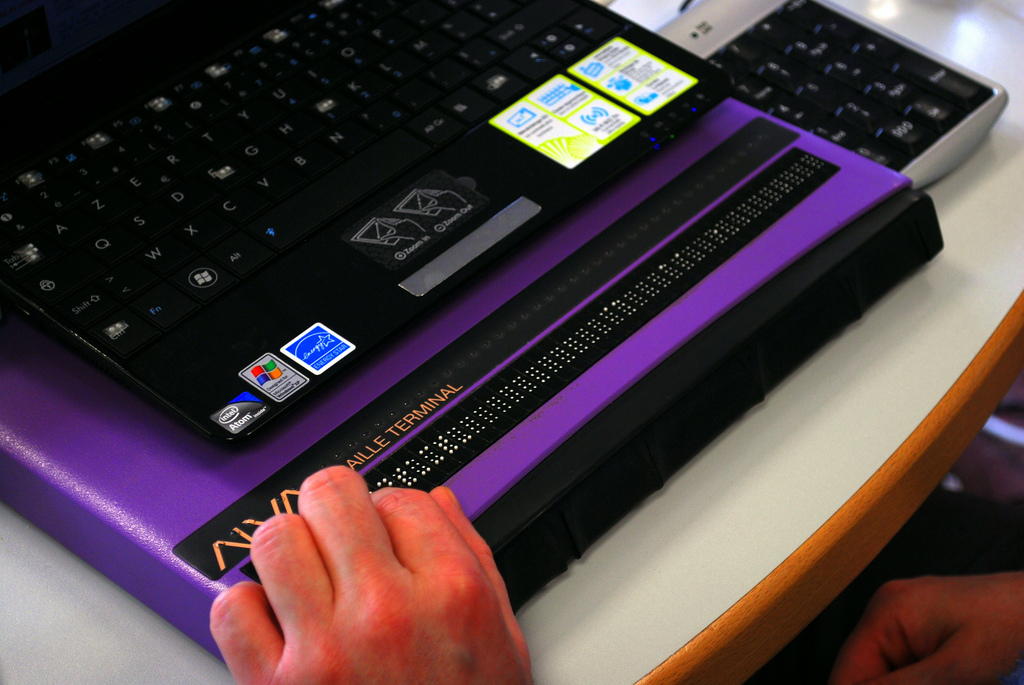Lesson 6People with special needs throughout project lifecycle
- Notion 40 - Understanding computer use of people with disabilities
- Notion 41 - Benefits of including people with disabilities on your project team
- Notion 42 - Recruiting people with special needs in Planning Usability Testing
- Notion 43 - The role of assistive technologies and choosing the best location during user testing
- Notion 44 - Learning from people with disabilities
- Notion 45 - Review of the main concepts
Notion 40
Understanding computer use of people with disabilities
Target skills
How do people with disabilities use computers?
People with Mobility-impairment may have trouble using the hardware of their computers (moving a mouse, pressing a switch, etc.) rather than understanding and interpreting information. Different solutions can be applied in this case:
- Keyboard guards and overlays. A thick plastic sheet with holes helps guide fingers to the correct key. It is useful if a person has cerebral palsy or a tremor that causes them to press different keys at a time or if they press the wrong keystrokes.
- A replacement mouse. This can include a device that operates using foot pedals, trackballs, or others.
- Slow keys and on-screen keyboards. These solutions are efficient since they can predict the word you are trying to type and the words that might follow it.
- Switch devices. Switches allow users with mobility impairments to operate their computer with one or two buttons that can be pressed whenever a person needs them.
Deaf and hard-of-hearing people may have fewer adaptation needs for their hardware since computers are largely silent devices that communicate visually. One can, for example, set the volume of a sound to zero and instead rely on a notification or menu bar to flash in place to transfer information. Unfortunately, assistive technology devices are somewhat limited for adapting to this disability. A hard of hearing person can use amplified headphones or a quality speaker, but these are standard additions that have no bearing on web design or programming.
A visual impairment may be one of the most significant disabilities affected by computer use.
- People with a relatively modest visual impairment require screen magnification software (enlarging the size of text, menu bars, and icons). Software designed for this purpose can also transform the mouse's cursor into a moving magnifying glass.
- People with a complete visual impairment will require a screen reader, a program that reads text, menus, and icons on the screen aloud.
- A deaf-blind person will use a braille display exclusively.

When it comes to people with learning disabilities, adaptive technology tools can help facilitate the demonstration of their various skills and compensate for the challenges they face.
A person with dyslexia can benefit from regular use of integrated word processor functions such as:
- Spell check
- Grammar check
- Changing font size and colour
Other individuals have difficulty organizing and integrating thoughts and ideas while writing. Concept mapping software allows for the visual representation of ideas and concepts. These representations are presented physically and can be linked with arrows to show the relationship between ideas. These graphically represented ideas can be connected, reordered, colour-coded, and combined with various icons to suit users' needs.
Speech recognition products provide proper tools for individuals with a wide range of learning difficulties. Speech recognition software takes the spoken word through a microphone and converts it into a machine-readable format. The user speaks into a microphone with pauses between words (discrete speech) or in a normal speaking mode (continuous speech).
A talking calculator is an appropriate device for people with dyscalculia. Hearing the calculated response can help these users who commonly reverse or transpose numbers.